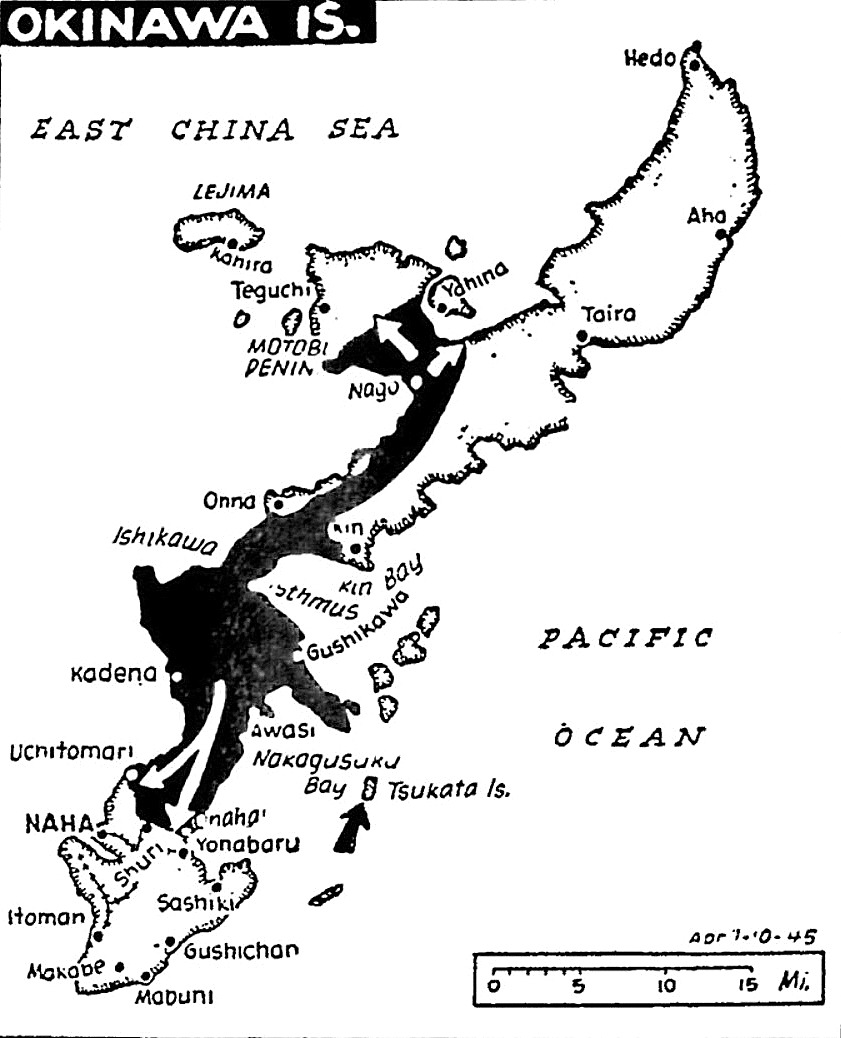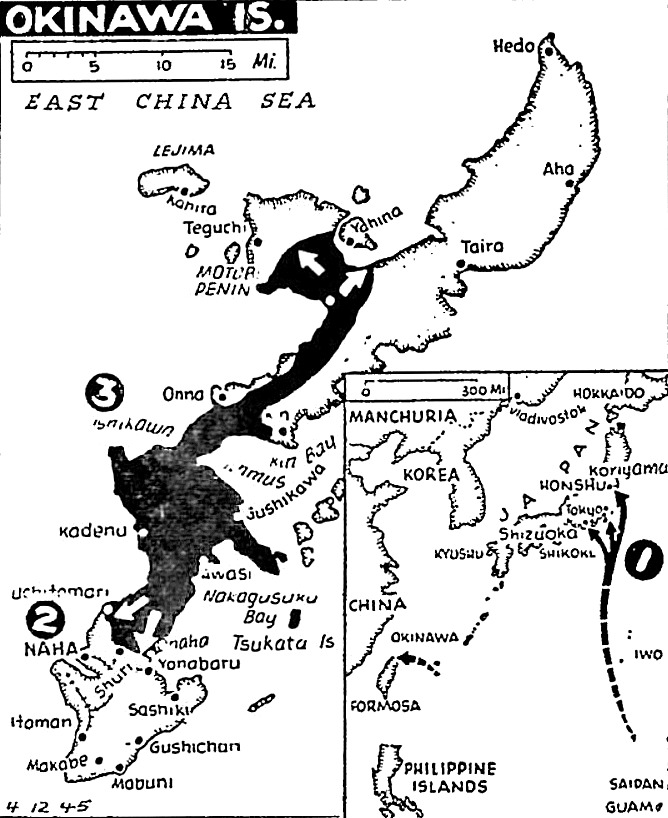The Pittsburgh Press (April 10, 1945)
Biggest artillery battle of Pacific war rages

New Pacific landing by U.S. troops on Tsukata Island, eight miles off the southeast coast of Okinawa, was reported by the Japs. U.S. forces on Okinawa reached Onaha on the southeast coast. Marines in the north sealed off Motobu Peninsula and occupied half of it.
GUAM (UP) – Tokyo said today that U.S. troops have landed on Tsukata Island controlling the entrance to nearly-conquered Nakagusuku Bay naval anchorage in Southeast Okinawa.
Other troops spearing along the shore of the bay on Okinawa advanced more than a mile and a half to Onaha, on the edge of Yonabaru Airfield and a mile and a half north of the port of Yonabaru itself, a Tokyo Domei Agency broadcast said.
Bud Foster of NBC, in a pooled broadcast from Okinawa today, said U.S. infantrymen were “attacking with heavy mortar fire pouring on them from deep, thick defense lines.” He said ambulances “virtually unused before yesterday,” were moving in long lines over narrow, muddy roads carrying wounded to the beach.
U.S. destroyers and other warcraft have already entered Nakagusuku Bay, the broadcast said.
Landing reported Sunday
U.S. sources were unable to confirm the reported east coast developments, but said the greatest artillery battle of the Pacific war was underway in the southwest coast sector as the U.S. XXIV Army Corps stormed deeper into defenses shielding the capital city of Naha.
Gen. O. P. Smith, deputy chief of staff for the Tenth Army, said more battalions of artillery were supporting the ground forces than ever before in the Pacific. The concentration of guns per yard nearly equals the maximum known in warfare, he said.
Domei said U.S. troops landed on Tsukata Island some eight miles off the southeast coast of Okinawa Sunday afternoon. The dispatch made no claim that the forces had been repulsed and it was possible the Americans quickly overran the tiny island.
During the landing operations, Tokyo said, Jap forces – presumably with artillery – sank one large American destroyer and a small craft.
More than two-thirds of the Okinawa coast of the bay has already been cleared by XXIV Army Corps troops. Yonabaru, its principal port, lies at the southwest corner.
Once Nakagusuku Bay has been cleared, the American command will have an excellent naval anchorage within easy striking range of the Jap homeland and the China coast.
Battle for caves
On the west coast and in the interior, U.S. soldiers were fighting from cave to cave and pillbox and pillbox, in a battle as vicious and as savage as ever fought in the Pacific, front dispatches said.
Gains were limited to enlarge the Americans fought to enlarge their wedge in the enemy’s major defense line two miles above Machinato Airfield and four miles north of Naha.
United Press writer Edward Thomas reported from the front:
The troops are doing a lot of traveling on their bellies in slow advances. One general described “White Hill” as the strongest prepared position he ever had seen and said steel and concrete reinforcements made it similar to spots in the Siegfried Line.
The 184th Regiment of the 7th Infantry Division captured a triangular Jap point of resistance centered on a burial vault in fierce fighting, but lost it to a Jap counterattack. Reorganizing, the Americans attacked from two sides and recaptured the point, this time holding it.
Jap broadcasts estimated that more than 100 U.S. warships, including eight battleships, were shelling Okinawa.
Naha itself, the largest and most modern city in the Ryukyu Island chain, was gradually being flattened by the unprecedented bombardment.
Jap guns were also laying down a heavy barrage.
In northern Okinawa, Marines of the III Amphibious Corps sealed off Motobu Peninsula and occupied half of it in advances of 3,000 to 4,000 yards against scattered and ineffective enemy resistance yesterday.
Blast 7 Jap planes
The thrust to the north completed the occupation of 160 of Okinawa’s 485 square miles.
Ten Jap planes attacked the Okinawa area during last evening and seven were destroyed. Two U.S. planes were lost in a collision over the Jap-held portion of the island. Their pilot parachuted, but the Japs fired on them as they floated toward the ground and little hope was held for either.
The Japs attempted several suicide boat attacks on American shipping off Okinawa. One suicide boat blew up too soon and the two Jap crewmen were killed as they attempted to swim to shore. The others were driven off before they could do any damage.

